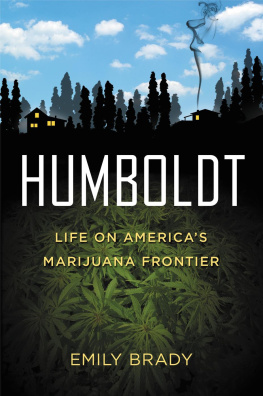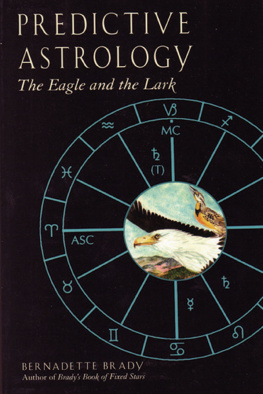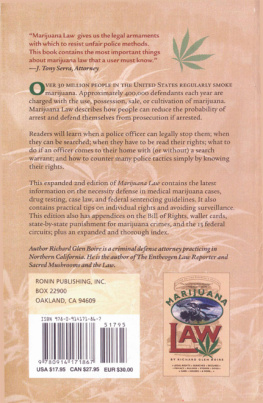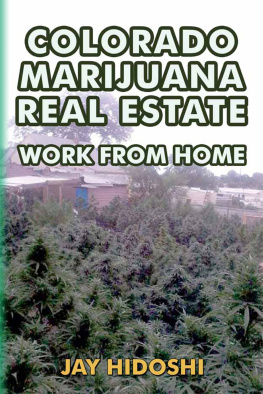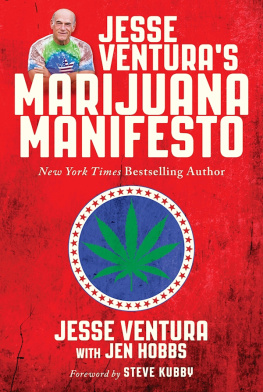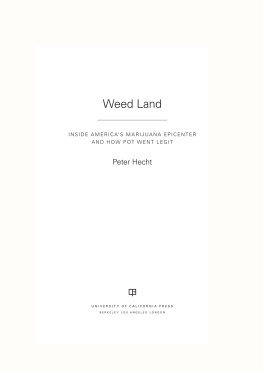This book is narrative nonfiction. The characters are real and the events happened. Passages expressing a persons thoughts or feelings have been fact-checked. Because the cultivation of marijuana remains a federal felony, despite state law, punishable by a sentence of up to life in prison, the names and certain identifying characteristics of some of the people in this book have been changed.
: Proposition 215, Californias 1996 medical marijuana law. Also, shorthand term for the doctors recommendation that allows one to use or grow marijuana for medicinal purposes.
Back-to-the-Land: A migration movement from cities to rural areas by American youth that began in the late 1960s.
Bank of the Woods: Cash savings that are buried or hidden on ones property, often in plastic tubes, glass jars, or recycled pickle or pepperoncini barrels.
CAMP: The Campaign Against Marijuana Planting. A multi-agency task force created in 1983 with the goal of eradicating marijuana cultivation throughout California.
CAMPed: A verb used by pot growers to describe a garden that has been destroyed or confiscated by law enforcement.
Cartels: Criminal organizations blamed by law enforcement for massive grows found on public land, despite lack of evidence linking them to Mexican organized crime.
Depping: Light deprivation; an agricultural technique of covering outdoor pot plants with a black tarp to simulate nightfall and induce flowering and an early harvest.
Diesel dope: Marijuana grown under lights powered by diesel-powered generators.
Fronting: Providing pot to a dealer on condition that you will be paid once the dealer sells it to someone else.
Guerrilla growing: Growing pot on someone elses land or public land without permission. More common among small growers before medical marijuana; now largely attributed to cartels.
Grow or Scene: A marijuana garden.
Grower: Someone who grows pot; could be six plants or six hundred.
Hempheimers: Marijuana-induced forgetfulness.
Hipneck: A hippie-redneck hybrid. Such a person might be named Sunshine, drive a big truck, and grow a lot of marijuana.
Homestead: A home built by its owner, often located off the electrical grid with no indoor plumbing and with a small marijuana patch growing out back next to the vegetable garden.
Humboldt time: A relaxed notion of time; the opposite of punctual.
Humboldt twenty: A hundred-dollar bill.
Marijuanaries: Places envisioned for some time in the future where tourists can visit and sample pot and learn about how it is grown and harvested.
Pot Princess: An attractive young woman who dates wealthy growers who have giant trucks and gardens. Also known by the more negative term potstitute.
F ollow the same path as the youth who once fled the city. From San Francisco, cross the Golden Gate and head north through the rolling hills of Marin, and then Sonoma County. Keep going. In the summertime, the landscape is a sun-scorched ocher. After the rains have begun, it is an Irish shade of green. Continue through the vineyards to Mendocino. Hours will pass. The grassy hills give way to ragged mountains, and the trees grow pointy and thick. On foggy days, the treetops catch the mist that billows in off the Pacific, and clumps of it hang there like fallen clouds.
Past the South Fork of the Eel River the road winds through a patch of ancient redwood forest called Richardson Grove State Park. These trees, the coast redwoods, are the tallest living things on earth. They come from another time; their ancestors provided shade for dinosaurs. Californias redwood forest once stretched from the Oregon border south to Big Sur. Then, in the 1850s, men who came west seeking adventure and riches discovered the beauty and durability of the wood. They called it red gold. Trees were leveled. Fortunes were made. Today, only 4 percent of Californias old-growth redwood forest remains, like a magnificent cathedral that has been knocked to the ground, with only its gilded altar left standing.
In Richardson Grove, the redwoods loom mere inches from the roadway, and the trunks of the larger ones may be wider than your car. The oldest tree in the grove is called the Grandfather. Shaped like a giant slingshot, with two trees sprouting from his base, the Grandfather is about twenty-four stories high and has stood for more than 1,800 years. His rings tell the story. Just beneath the fibrous bark, man landed on the moon. Deeper inside, Columbus sailed across the Atlantic. Toward the core, Mayans were beginning to carve their language into temple walls.
Inside the grove, even on a warm summer day, it is dark and cool. Most of the sunlight is caught in the branches of the giants high above, but in places, it filters down, leaving delicate lacelike patterns on the road.
Keep driving. Youre almost there. Richardson Grove marks the unofficial entrance to Humboldt County. Pass through it and youll begin to understand the local saying about living in a world that exists behind the redwood curtain.
L ate one Tuesday afternoon in March of 2010, in a disorderly cabin located on the edge of the North American continent, in a place bypassed by highways and the electrical grid, Mary Em Abidon reached deep into her freezer, plucked out a small white marrowbone, and tossed it onto her pantry floor. Her dog, Lucky, was nearly deaf, but the unmistakable thunk of bone hitting wood could still roust him from his slumber. It was a familiar routine between Mare, as she was known to most everyone, and the border collie/cocker spaniel mutt she found abandoned on the road to Shelter Cove fourteen years earlier.
As Mare bent down to scratch behind Luckys floppy black ears and pat his head, the little dog peered up at her with pleading eyes.
Lucky, stay and guard, she instructed him, as she always did before she left for town.
Lucky picked up his treat and headed for the front deck to curl up under the cherry trees that were just beginning to bud, while Mare gathered up her coat and purse and pulled the cabin door shut behind her. She was excited, giddy even, as she started up her battered Volvo station wagon and eased it down her driveway and toward town. It was the same fluttery feeling she had long ago when she first moved to this place. It felt like the start of something new.
Mare had first heard about the event while listening to KMUD-FM, the community radio station. A local talk show host named Anna Banana Hamilton was organizing it. The flyers she posted around town advertised the event two ways: The Post-Marijuana Prohibition Economy Forum, and the shorthand version, which rolled off the tongue much easier: Whats After Pot? The accompanying art featured a pot leaf, two nude female figures wearing baseball caps, clumps of trimmed marijuana buds, and what appeared to be dollar bills with wings fluttering away. Smaller print near the bottom of the flyer advised attendees to bring their own snacks.
On her way to town, Mare caught slivers of the steel-blue Pacific Ocean through the trees, but mostly all she could see were the trees themselves. On her right, madrones and Douglas firs plunged down the canyon. On her left, they furrowed their roots deep into the hillside. The Volvo rattled past a row of brightly painted mailboxes and the dirt road that led to the meadow where the annual Easter egg hunt and the May and October trade fairs were held. Farther ahead was the tiny community school where years earlier Mare had volunteered as an art teacher, teaching the children how to make paper and pinch clay into faces that they would stick to trees until the rain washed them away.

